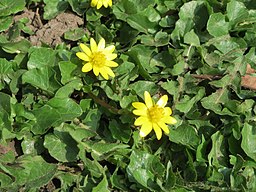Note: This is a project under development. The articles on this wiki are just being initiated and broadly incomplete. You can Help creating new pages.
Difference between revisions of "Ficaria verna - Fig buttercup"
(Created page with "thumb|right|''Ficaria verna'' '''Ficaria verna''', (formerly Ranunculus ficaria L.) commonly known as lesser celandine, is a low-grow...") |
(No difference)
|
Revision as of 10:28, 28 December 2016
Ficaria verna, (formerly Ranunculus ficaria L.) commonly known as lesser celandine, is a low-growing, hairless perennial flowering plant in the buttercup family Ranunculaceae native to Europe and west Asia. It has fleshy dark green, heart-shaped leaves and distinctive flowers with bright yellow, glossy petals.[1] The plant is poisonous if ingested raw and potentially fatal to grazing animals and livestock such as horses, cattle, and sheep.
Description
Lesser celandine is a hairless perennial, with spirally-arranged cordate dark-green leaves without stipules. It produces actinomorphic (radially symmetrical) flowers with 3 sepaloid tepals and 7-12 glossy yellow petaloid tepals. Double flowered varieties also occur. The stamens and carpels are numerous, and the fruit is a single-seeded achene with a very short style. In several sub-species, tubers are formed in the leaf axils after flowering.
Ficaria verna sensu lato is native to central Europe, north Africa and the Caucasus. It is not native in North America
Uses
- The plant is known as pilewort by some herbalists because it has historically been used to treat piles
- Lesser celandine is still recommended in several "current" herbal guides for treatment of hemorrhoids by applying an ointment of raw leaves as a cream or lanolin to the affected area.[2]
